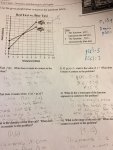You are using an out of date browser. It may not display this or other websites correctly.
You should upgrade or use an alternative browser.
You should upgrade or use an alternative browser.
If g(x) = 5, what is the value of x?
- Thread starter grinboy1
- Start date
- Joined
- Feb 4, 2004
- Messages
- 16,582
Keep in mind that "g(x)" is just a fancy name for "y". So this question is asking, "When y = 5, what is the corresponding value of x?" They use the name "g(x)" for this question because otherwise you wouldn't know which line they meant.For some reason I am drawing a blank on number 2 in the pic here: "If g(x) =5, what is the value of x? What does it mean in context to the problem?
Thanks - That was what I thought.

Keep in mind that "g(x)" is just a fancy name for "y". So this question is asking, "When y = 5, what is the corresponding value of x?" They use the name "g(x)" for this question because otherwise you wouldn't know which line they meant.
So on the graph, we go to the point in the line g(x) that corresponds to X when g(x) = 5 (5 on y axis).
Would x then equal 1.5?
You are correct Grinboy - g(1.5) = 5 from your graph where y = g(x) is a function.
When x = 1.5, y = 5
What do you think this means in the context of this problem?
Hint:
g(x) represents cost of travel in red taxi
What does x represent?
How much does it cost for the red taxi to travel 1.5 miles?
Last edited:

